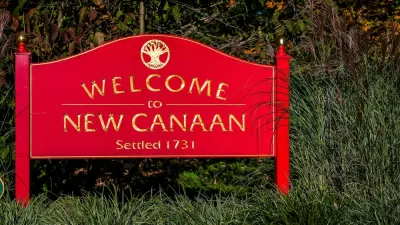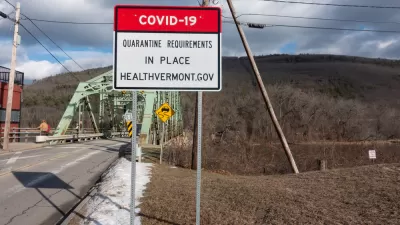It's not bad enough that the Northeast is losing population to the South and West. As companies decamp from the suburbs, pristine communities, many where apartments are outlawed, are seeing a steady decline in housing values.
"Cities are in vogue again, and that’s starting to be a problem for places that are made up mostly of suburbs," writes Alana Semuels for The Atlantic about demographic changes in New England's suburbs, and their effect on housing values.
This month General Electric began their long heralded move from their 68-acre suburban campus in Fairfield, Conn. to Boston's Seaport District. It is one of many companies departing leafy suburbs for city centers. When companies leave, a drop in housing values may not be far behind.
Around Boston, for example, 51 towns and suburbs started the year with price declines while the city’s prices skyrocketed.
Semuels reports from New Canaan, Connecticut, a wealthy, suburb known for its "super jumbo homes" just over an hour away from Grand Central Station on Metro North's busy New Haven line.
"We have a glut of inventory," a real estate agent tells Semuels. "The number of days homes stay on the market has increased, and people are getting so desperate they’re renting out their homes."
This is a big change from a decade ago, according to planners who study job creation in the New York metro region.
Between 1975 and 2005, 90 percent of the jobs created in the New York region, which includes suburban Connecticut and New Jersey, were created outside New York City, according to Chris Jones, chief planner with the Regional Plan Association, a research group that studies the New York-New Jersey-Connecticut region.
In the last 10 years, 90 percent of the jobs created have been in New York City. In the past decade, New York City has added 600,000 jobs, while the entire rest of the region has added just 88,000. “It’s a reversal of what it was through most of the postwar period,” he said.
The problem, Jones adds, is that homes are still too expensive for millennials and others who might consider living there.
“The mainstay of the Connecticut model; these wealthy suburban communities within commuting distance to larger cities, is not really a sustainable model,” Ellen Shemitz, the executive director of the nonprofit Connecticut Voices for Children, told [Semuels].
One solution: create more affordable housing, but many of these suburbs either don't allow multifamily housing to be built, or make it difficult for developers, requiring a special permit.
Long-term demographic changes affecting region
In addition to companies leaving suburbs, the long-term challenge facing northeast suburbs is the flight of residents to the South and West. "Between 2014 and 2015, Connecticut lost nearly 4,000 residents as Florida added 366,000," reported Semuels.
The losses are exacerbated by the fact that the region’s median age is growing. Connecticut, alongside New England neighbors Maine, New Hampshire, and Vermont, is one of only a few states to have a median age over 40, which means half of its population is over child-bearing age, according to Peter Francese, [Director of Demographic Forecasts for The New England Economic Partnership.]
“Connecticut is a basketcase demographically, as are many of the states in New England,” Francese told [Semuels].
John Karras compares growth for all 382 U.S. metro areas over the last fives years in an Aug. 18 blog for Urban Scale.
The regional growth contrasts are stark. Of the 10 fastest growing large metro areas, all of them are in the South or the West. And of the 10 slowest growing large metro areas, all of them are in the Midwest and Northeast.
Hat tip to Los Angeles County Metro: "L.A. Transportation Headlines"
FULL STORY: An Unsteady Future for New England's Suburbs

Planetizen Federal Action Tracker
A weekly monitor of how Trump’s orders and actions are impacting planners and planning in America.

Congressman Proposes Bill to Rename DC Metro “Trump Train”
The Make Autorail Great Again Act would withhold federal funding to the system until the Washington Metropolitan Area Transit Authority (WMATA), rebrands as the Washington Metropolitan Authority for Greater Access (WMAGA).

The Simple Legislative Tool Transforming Vacant Downtowns
In California, Michigan and Georgia, an easy win is bringing dollars — and delight — back to city centers.

The States Losing Rural Delivery Rooms at an Alarming Pace
In some states, as few as 9% of rural hospitals still deliver babies. As a result, rising pre-term births, no adequate pre-term care and "harrowing" close calls are a growing reality.

The Small South Asian Republic Going all in on EVs
Thanks to one simple policy change less than five years ago, 65% of new cars in this Himalayan country are now electric.

DC Backpedals on Bike Lane Protection, Swaps Barriers for Paint
Citing aesthetic concerns, the city is removing the concrete barriers and flexposts that once separated Arizona Avenue cyclists from motor vehicles.
Urban Design for Planners 1: Software Tools
This six-course series explores essential urban design concepts using open source software and equips planners with the tools they need to participate fully in the urban design process.
Planning for Universal Design
Learn the tools for implementing Universal Design in planning regulations.
Smith Gee Studio
City of Charlotte
City of Camden Redevelopment Agency
City of Astoria
Transportation Research & Education Center (TREC) at Portland State University
US High Speed Rail Association
City of Camden Redevelopment Agency
Municipality of Princeton (NJ)




























